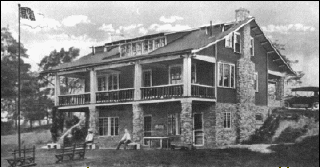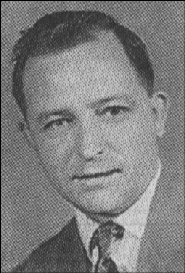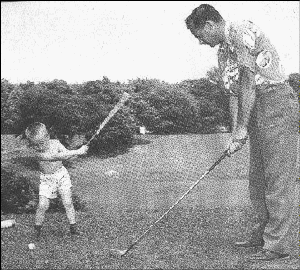Sidney
Country Club -- now known as the Moose.

Area golfers have followed with interest the accomplishments
of Fairlawn's senior golfer Ryan
Coyne, son of Tom and Sally Coyne. He won the district championship, a first for a
Fairlawn golfer, and finished fourth overall in the state meet in his division recently.
Many senior golfers may remember another local phenom, and the trail of glory he blazed
across the links over 58 years ago. It was to be a Cinderella season for this Sidney High
School athlete like no other in the history of the school. The recent successes of Ryan
Coyne bring to mind the accomplishments of that great golfer. This is his story.
In the 1930s, golf was a spring sport, along with tennis and track and field. The 1939
edition of the 'thinclads' (as the track and field performers were known then) were
expected to be a mediocre team at best, but many thought the tennis squad, led by Fred
Dull and Bill Binkley would challenge the best teams in the area. After graduation, Fred
Dull was destined to play a key role in the dynamic growth of Monarch Machine Tool company.
When coach Rodney Kolb assembled the Yellow Jacket golf team, there was talk in the
community that the squad had promise, but that some of the younger players would have to
come through. Among those youngsters was a sophomore named Bernie Kerns. Kerns was one of
seven brothers, and all were good athletes. Besides golf, Bernie's other love was basketball. He was destined to be
the star of the Sidney High School team during his last two years in school. Although only
five feet eight inches tall, he played point guard and served as team captain his senior
year.
Coach Kolb knew he had something special in Bernie Kerns. Under the tutelage of his
father, Bernie had played the game since he was six years old. At the age of eleven, he
switched from a left handed to a right handed player. By the age of 13, he was shooting in
the 30s for nine holes. High school competition, however, might prove to be a different
story. As the 1939 golf season began to unfold, things went well for Bernie. Sidney's home
course was the Sidney Country Club (It subsequently became the home of the Moose). Bernie
soon began to master the course as if he had designed it. Against Lima Central early in
the season, he shot a 72, besting everyone else by four shots. Living a nightmare all too
familiar to many golfers, Robbins of Sidney missed a two foot putt on the last hole to
give Lima Central a tie in the match. Just three days later, Kerns again shot a 72,
beating his opponent by 14 strokes as Sidney thumped Piqua.
During the weeks that followed, Bernie
continued to dominate the competition. He beat the number one players for Troy and Urbana
by nine strokes each. The result was no different when Sidney traveled there for the
matches.
For the Miami Valley League championship, the six league teams traveled to
Miamisburg to play the Mound Course. Twenty-four golfers teed off that day, and by the end
of the afternoon, Kerns was again leading the pack. Bill Ross reported for the Sidney
Daily News on May 8th that Kerns had fired a 77 - an amazing eight strokes better than
his nearest competitor. Having earned medallist honors, he was awarded first prize: a
single golf ball.
Even golfers on a Tiger Woods type of run falter on occasion. Against Lima Central on
the Shawnee course in Lima, Kerns was bested by teammate Les Valentine for medallist
honors. Bernie tied his opponent, however, to keep his unbeaten streak alive. That would
be the closest he would come to losing a match. During the next week the talk among the
golfers was about the upcoming match between Kerns and Don Pendergast of Lima South,
Sidney's next opponent. Pendergast, a seasoned senior, had not lost a high school match in
three years. Sophomore Kerns was on a roll, but to beat Pendergast would be a tall order.
Sophomore Kerns was on a roll, but to beat Pendergast would be a tall order. The match
was played on the Sidney County Club course. By the end of the first nine holes, Bernie
was two up as he carded a 38. He caught fire on the second nine, torching the course for a
three under par 32. Kerns' 70 was ten shots better than Pendergast's 80. The Sidney
sophomore had peaked at the right time. The district meet was next.
 Unlike today, when athletes are divided into
classes based upon the size of their school, in 1939 all the golfers competed head to head
for the chance to qualify for the state meet. Sidney competed in the Dayton district. Bill
Ross again reported on the action for the Daily News. The headline on the sports
page the next Monday morning told it all: "KERNS SHOOTS SENSATIONAL 69" The
golfers played the tough Snyder Park golf course in Springfield. Ross marveled:
"Kerns' medal score, which was eight strokes better than runner-up Hamant of Dayton
Chaminade, was little short of spectacular to say the least." Bernie collected six
birdies and an eagle to finish three under par. His score of 69 was the lowest district
score in district play ever recorded. Zack Crusey noted in a column 13 years later that
Kerns' record was still unequalled up to that point . Unlike today, when athletes are divided into
classes based upon the size of their school, in 1939 all the golfers competed head to head
for the chance to qualify for the state meet. Sidney competed in the Dayton district. Bill
Ross again reported on the action for the Daily News. The headline on the sports
page the next Monday morning told it all: "KERNS SHOOTS SENSATIONAL 69" The
golfers played the tough Snyder Park golf course in Springfield. Ross marveled:
"Kerns' medal score, which was eight strokes better than runner-up Hamant of Dayton
Chaminade, was little short of spectacular to say the least." Bernie collected six
birdies and an eagle to finish three under par. His score of 69 was the lowest district
score in district play ever recorded. Zack Crusey noted in a column 13 years later that
Kerns' record was still unequalled up to that point .
It was with a high degree of
confidence that Bernie Kerns approached the state meet the next weekend. Once again, he
would be competing against all the other district qualifiers from across the state,
regardless of school size. Kerns planned to challenge par again, but Mother Nature had
other plans. Ryan Coyne also faced adverse weather conditions in 1996 at the state meet.
Over half a decade earlier, Bernie Kerns experienced the same problem. On that day in late
May of 1939, the wind and rain harassed the golfers unmercifully. Bernie shot a 77 to
finish in 6th place. He was disappointed in his finish, but he had just finished what
could arguably be described as the greatest season of accomplishments by a sophomore in
the history of Sidney High School.
Bernie Kerns never made it back to the state meet. He did not lose one match play event
during his junior and senior seasons, but he never repeated the trip to Columbus. Upon
graduation in 1941, Bernie Kerns went off to war with so many other classmates. He served four years with the Navy Seabees in the South
Pacific. When he got out of the service, Bernie returned to his home town. In 1947 he
began working at the Moose golf course as head greenskeeper and course pro. He also
married Aunalee Crusey that year. She was a champion in her own right, having won seven
national casting championships as a teenager.
Many area players thought that Kerns could have easily made the pro golf tour. Bill
Kenton, a regional golf writer, wrote a column on Bernie in July of 1951. He correctly
observed that "Bernie was chalking up better scores as a Soph in high school than
most pros who made their living at it." Kenton added: "Kerns was to Sidney High
School golf what Jerry Brown as to Sidney High School football."
Bernie never made it to the pros.
The necessity of a steady job and the raising of his new son, Steve, were more important.
After five years as golf pro, Bernie accepted employment at Monarch in 1952. He remained
there, working in the service department, for over 25 years. As his father had done before
him, Bernie passed on his love of the game of golf to his son. Steve played varsity golf
for Sidney High School.
Bernie Kerns never lost his love for the game of golf. He
struggled with diabetes for over two decades prior to his death. Due poor circulation
problems, he lost a leg in 1989. Bernie remained one of the best golfers in the area. He
passed away in 1994.
Bernie never made it to the pros.
The necessity of a steady job and the raising of his new son, Steve, were more important.
After five years as golf pro, Bernie accepted employment at Monarch in 1952. He remained
there, working in the service department, for over 25 years. As his father had done before
him, Bernie passed on his love of the game of golf to his son. Steve played varsity golf
for Sidney High School.
Bernie Kerns never lost his love for the game of golf. He
struggled with diabetes for over two decades prior to his death. Due poor circulation
problems, he lost a leg in 1989. Bernie remained one of the best golfers in the area. He
passed away in 1994.

Bernie Kerns (at right)
plays golf with his son, Steve, age 4, at the Moose Lodge golf course in 1952.
For a time,
he was golf pro at the Lodge.
[ Back to Sports Index ] |

